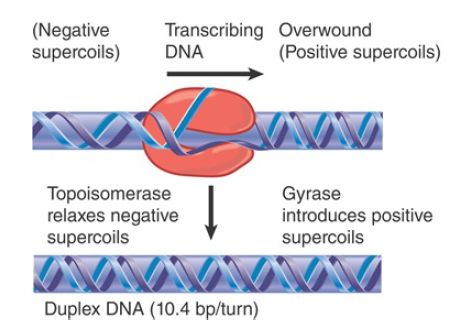


 النبات
النبات
 الحيوان
الحيوان
 الأحياء المجهرية
الأحياء المجهرية
 علم الأمراض
علم الأمراض
 التقانة الإحيائية
التقانة الإحيائية
 التقنية الحيوية المكروبية
التقنية الحيوية المكروبية
 التقنية الحياتية النانوية
التقنية الحياتية النانوية
 علم الأجنة
علم الأجنة
 الأحياء الجزيئي
الأحياء الجزيئي
 علم وظائف الأعضاء
علم وظائف الأعضاء
 الغدد
الغدد
 المضادات الحيوية
المضادات الحيوية|
Read More
Date: 24-5-2021
Date: 19-12-2015
Date: 15-5-2016
|
Supercoiling Is an Important Feature of Transcription
KEY CONCEPTS
- Negative supercoiling increases the efficiency of some promoters by assisting the melting reaction.
- Transcription generates positive supercoils ahead of the enzyme and negative supercoils behind it, and these must be removed by gyrase and topoisomerase.
Both prokaryotic and eukaryotic RNA polymerases usually seem to initiate transcription more efficiently in vitro when the template is supercoiled, and in some cases promoter efficiency is aided tremendously by negative supercoiling. Why are different promoters influenced more by the extent of supercoiling than others? The most likely possibility is that the dependence of a promoter on supercoiling is determined by the free energy needed to melt the DNA in the initiation complex. The free energy of melting, in turn, is dependent on the DNA sequence of the promoter. The more G+C rich the promoter sequence corresponding to the position of the transcription bubble, the more dependent the promoter would be on supercoiling to help melt the DNA.
However, whether a particular promoter’s activity is facilitated by supercoiling is much more complicated. The dependence of different promoters on the degree of supercoiling is also affected by DNA sequences outside of the bubble, because supercoiling changes the geometry of the complex, affecting the angles and distances between bases in space. Therefore, differences in the degree of supercoiling can alter interactions between bases in the promoter and amino acids in RNA polymerase. Furthermore, because different parts of the chromosome exhibit different degrees of supercoiling, the effect of supercoiling on a promoter’s activity can be influenced by the location of the promoter on the chromosome.
As RNA polymerase continually unwinds and rewinds the DNA as it moves down the template , either the entire transcription complex must rotate around the DNA or the DNA itself must rotate about its helical axis. It is thought that the latter situation is closer to reality: The DNA threads through the enzyme like a screw through a bolt.
One consequence of the rotation of DNA is illustrated in FIGURE 1. In the twin domain model for transcription, as RNA polymerase moves with respect to the double helix it generates positive supercoils (more tightly wound DNA) ahead of it and leaves negative supercoils (partially unwound DNA) behind it. For each helical turn traversed by RNA polymerase, +1 turn is generated ahead and −1 turn behind. Transcription therefore not only is affected by the local structure of DNA but also affects the actual structure of the DNA. The enzymes DNA gyrase, which introduces negative supercoils into DNA, and DNA topoisomerase I, whichremoves negative su percoils in DNA, are required to prevent topological stresses from building up in the course of transcription and replication. Blocking the activities of gyrase and topoisomerase therefore results in major changes in DNA supercoiling, which, in turn, affect transcription and replication. This was discussed earlier in the context of replication .

FIGURE 1. Transcription generates more tightly wound (positively supercoiled) DNA ahead of RNA polymerase, while the DNA behind becomes less tightly wound (negatively supercoiled).



|
|
|
|
تفوقت في الاختبار على الجميع.. فاكهة "خارقة" في عالم التغذية
|
|
|
|
|
|
|
أمين عام أوبك: النفط الخام والغاز الطبيعي "هبة من الله"
|
|
|
|
|
|
|
قسم شؤون المعارف ينظم دورة عن آليات عمل الفهارس الفنية للموسوعات والكتب لملاكاته
|
|
|